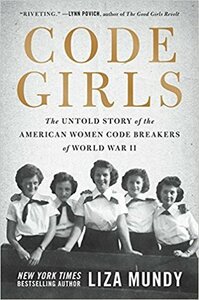You need to sign in or sign up before continuing.
Take a photo of a barcode or cover
759 reviews for:
Code Girls: The Untold Story of the American Women Code Breakers Who Helped Win World War II
Liza Mundy
759 reviews for:
Code Girls: The Untold Story of the American Women Code Breakers Who Helped Win World War II
Liza Mundy
inspiring
sad
informative
reflective
medium-paced
Lots of technical jargon, but I enjoyed the personal stories.
challenging
emotional
informative
reflective
slow-paced
This is a palatable biography about the women behind the intelligence operations of WWII. It is a bit long but it tells the story of so many that I feel the length is justified. I like that it's a storytelling history and not dry facts, it comes with the tea. Probably the hardest part of this aspect is that it isn't a linear book, the time lines jump a lot so you need to pay a bit more attention. Overall, I'd recommend it to those interested in WWII, military history, or the roles of women in American history.
hopeful
informative
medium-paced
adventurous
informative
reflective
tense
medium-paced
I listened to the audiobook. The narrator did a great job. The audiobook is absolutely amazing. The writing is very vivid.
I think it is a great book introducing about women at WWII and their contributions. It broke my heart to know how little recognition they received and how the social norm at that time limited their future.
It is very patriotic and I hope it could be less like that.
I think it is a great book introducing about women at WWII and their contributions. It broke my heart to know how little recognition they received and how the social norm at that time limited their future.
It is very patriotic and I hope it could be less like that.
I listened to the audiobook version of Code Girls, though in hindsight, I wish I’d read a physical copy. The format made it hard to follow at times, but the subject matter kept me hooked.
This is an extraordinary, long-overdue spotlight on the women who served as codebreakers during World War II. Before reading this, I had no idea how integral these women were to the war effort. After watching The Six Triple Eight on Netflix, I found myself wanting to explore more stories like this—where women are not just support staff, but the backbone of strategy, innovation, and success.
What stood out to me was how these women overcame societal and institutional sexism, broke into top-secret work, and made vital contributions—without fanfare or recognition. The book reminds us how often women are left out of history books, even when they help shape the very world we live in.
Notable Figures in Code Girls:
While this book is nonfiction and doesn’t follow traditional characters, here are some of the standout women featured:
• Dot Braden – A feisty, determined schoolteacher from Virginia who becomes one of the earliest recruits to Arlington Hall. Her story grounds much of the book.
• Ann Caracristi – A brilliant analyst who eventually rose to become the first female deputy director of the NSA. Her work on Japanese ciphers was game-changing.
• Genevieve Grotjan Feinstein – The mathematician who cracked the Japanese “Purple” cipher machine, paving the way for U.S. intelligence breakthroughs.
• Agnes Meyer Driscoll – One of the few women already in Navy cryptanalysis before WWII; she trained many of the incoming code girls and set a powerful example.
Mundy’s research is rich and detailed, and though the narrative can be dense, the takeaway is clear: These women weren’t “supporting the war effort” from the sidelines—they were front and center, saving lives with intellect, not rifles.
This is an extraordinary, long-overdue spotlight on the women who served as codebreakers during World War II. Before reading this, I had no idea how integral these women were to the war effort. After watching The Six Triple Eight on Netflix, I found myself wanting to explore more stories like this—where women are not just support staff, but the backbone of strategy, innovation, and success.
What stood out to me was how these women overcame societal and institutional sexism, broke into top-secret work, and made vital contributions—without fanfare or recognition. The book reminds us how often women are left out of history books, even when they help shape the very world we live in.
Notable Figures in Code Girls:
While this book is nonfiction and doesn’t follow traditional characters, here are some of the standout women featured:
• Dot Braden – A feisty, determined schoolteacher from Virginia who becomes one of the earliest recruits to Arlington Hall. Her story grounds much of the book.
• Ann Caracristi – A brilliant analyst who eventually rose to become the first female deputy director of the NSA. Her work on Japanese ciphers was game-changing.
• Genevieve Grotjan Feinstein – The mathematician who cracked the Japanese “Purple” cipher machine, paving the way for U.S. intelligence breakthroughs.
• Agnes Meyer Driscoll – One of the few women already in Navy cryptanalysis before WWII; she trained many of the incoming code girls and set a powerful example.
Mundy’s research is rich and detailed, and though the narrative can be dense, the takeaway is clear: These women weren’t “supporting the war effort” from the sidelines—they were front and center, saving lives with intellect, not rifles.
informative
inspiring
slow-paced


